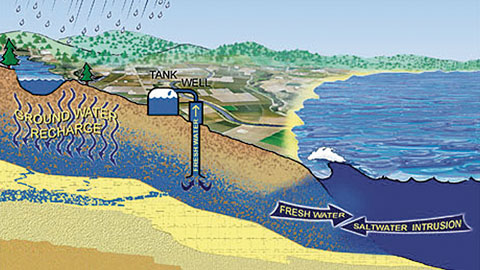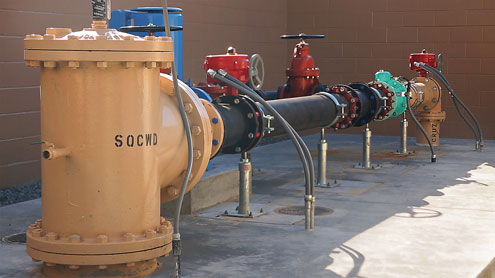By Rebecca Gold Rubin, Soquel Creek Water District
Every August is National Water Quality Month — an annual opportunity to remind ourselves of the crucial importance of water in our everyday lives and the necessity to protect the quality of our drinking water, our lakes and waterways, and our oceans.
 For this year’s National Water Quality Month, we want to emphasize that a key tenet of the District’s mission is to provide safe, high-quality water to meet our community’s present and future needs.
For this year’s National Water Quality Month, we want to emphasize that a key tenet of the District’s mission is to provide safe, high-quality water to meet our community’s present and future needs.
So, what do we do to ensure your drinking water is of the highest quality? We regularly test the water from each of our groundwater wells, which provide all the water that we treat and deliver to your homes and businesses. This is no small task — we test for over 130 possible contaminants, and then report the results to the community in our annual Water Quality Report.
Our treatment processes are operated to ensure that any contaminants that may be found are removed or reduced to safe levels regulated by the State and Federal Drinking Water Standards before water is pumped into the distribution system. Please take a look at our Water Quality Reports on our website at www.soquelcreekwater.org/waterqualityreports.
 Our water quality goals extend to the new water supplies that the District is pursuing — purified recycled water and surface water transfers. The Pure Water Soquel project, which is just beginning construction, will put recycled water (purple pipe water) through an additional, three-step advanced purification process: microfiltration, reverse osmosis, and ultraviolet light with advanced oxidation. This process produces purified water.
Our water quality goals extend to the new water supplies that the District is pursuing — purified recycled water and surface water transfers. The Pure Water Soquel project, which is just beginning construction, will put recycled water (purple pipe water) through an additional, three-step advanced purification process: microfiltration, reverse osmosis, and ultraviolet light with advanced oxidation. This process produces purified water.
Those enhanced purification and disinfection treatments are similar to those that are used today by bottled water companies, baby food manufacturers, and kidney dialysis machines.
The purified water will be pumped underground to blend with and replenish the groundwater basin. In addition to providing a drought-proof water supply, recharging the groundwater is a key tool in preventing seawater intrusion. With saltwater already creeping inland and threatening our entire water supply, replenishing the groundwater basin will raise groundwater levels. Thus, creating a barrier preventing that saltwater from entering and contaminating the District’s wells, and the thousands of other wells that share our groundwater basin.
 For surface water transfers with the City of Santa Cruz, the District and City are conducting a pilot project to evaluate the water quality conditions when blending surface water and groundwater. The chemical characteristics of groundwater and water from surface water sources (reservoirs and rivers) are different. Surface water supplies will tend to be softer with lower levels of naturally occurring minerals that, without treatment, will tend to be more corrosive than groundwater supplies.
For surface water transfers with the City of Santa Cruz, the District and City are conducting a pilot project to evaluate the water quality conditions when blending surface water and groundwater. The chemical characteristics of groundwater and water from surface water sources (reservoirs and rivers) are different. Surface water supplies will tend to be softer with lower levels of naturally occurring minerals that, without treatment, will tend to be more corrosive than groundwater supplies.
Surface water will also tend to have higher levels of total organic carbon than groundwater. While the levels of organic carbon in surface water sources vary considerably, disinfecting water containing organic carbon as part of the water treatment process results in the formation of disinfection byproducts such as trihalomethanes and haloacetic acids.
Unless the organic carbon is removed before the disinfection step in the treatment process, disinfection byproducts can continue to form as the water travels through the distribution system. Recent issues with source water changes in Flint, Michigan, and Fresno, California, are reasons our two agencies are working together to conduct the pilot project and are exercising prudent planning for implementing water transfers in the future.
Those are just some of the things we are doing to protect water quality.
What can you and your family do? Here are a few ideas:
- Put nothing but water down storm drains. Water in those drains flows to our natural waterways, the groundwater, and the ocean, taking with it any contaminants or trash it may contain. Only stormwater and other clean water should go into storm drains — no litter, chemicals, soaps, pool water, or other water that contains harsh chemicals.
- Decrease polluted runoff on your property by replacing paved surfaces, where possible, with low-water-use landscaping or porous surfaces.
- Avoid using chemical fertilizers and pesticides. These can easily wash off your property and enter the natural water system, ending up in waterways.
- Choose non-toxic cleaners, avoid antibacterial soaps, and never put medications down the drain or toilet.
- Pick up after your pets — that waste material can also get washed away into the storm drains.
- Check your vehicles for fluid leaks — this ends up on the street and eventually into the natural water system.
- Try to patronize only “green” car washes that recycle their water.
We’d love to hear from you with other ways you and your family are helping to protect and maintain water quality – feel free to send us a note to [email protected]. We’ll share your ideas in an upcoming article.
Our water quality depends on a partnership between the District and the community we serve. If we all do our parts, we can rely on a clean, safe, and reliable water supply for generations to come.
•••
For more information about the Soquel Creek Water District, visit www.soquelcreekwater.org, and learn more about the Pure Water Soquel Groundwater Replenishment and Seawater Intrusion Prevention Project, at www.soquelcreekwater.org/pws.

